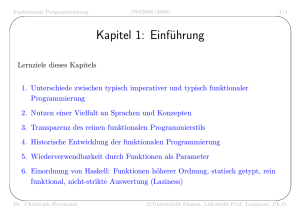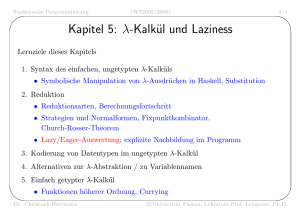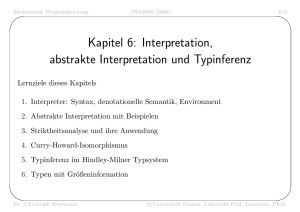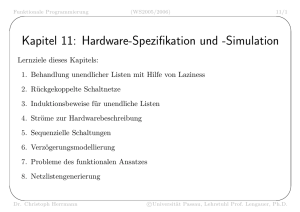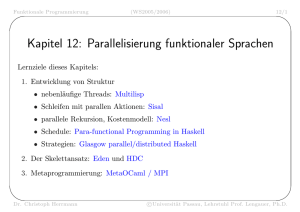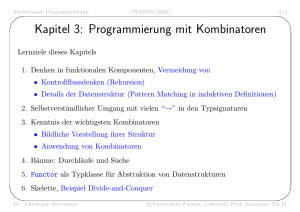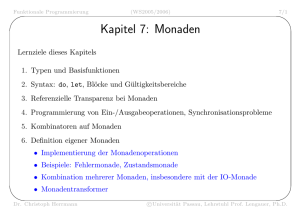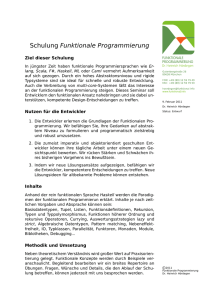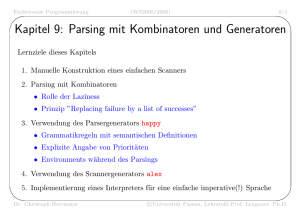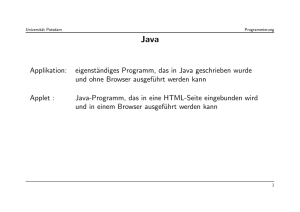Grundlegende Elemente der Sprache Haskell
Werbung
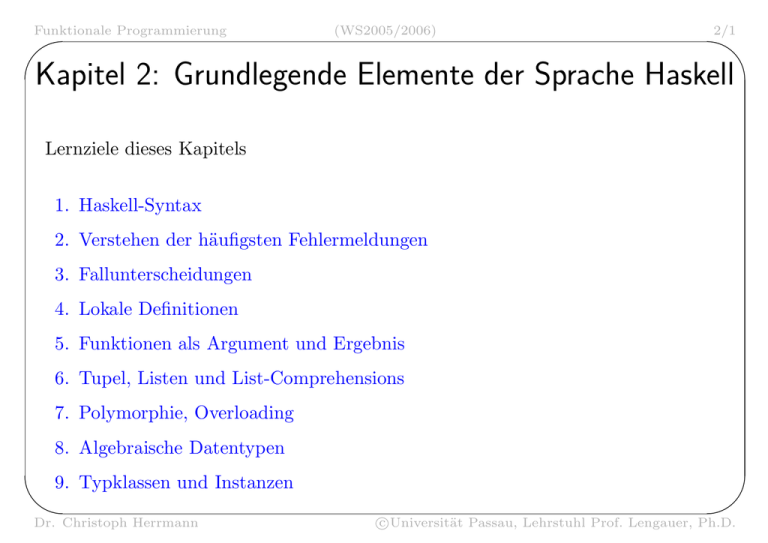
Funktionale Programmierung
'
(WS2005/2006)
2/1
$
Kapitel 2: Grundlegende Elemente der Sprache Haskell
Lernziele dieses Kapitels
1. Haskell-Syntax
2. Verstehen der häufigsten Fehlermeldungen
3. Fallunterscheidungen
4. Lokale Definitionen
5. Funktionen als Argument und Ergebnis
6. Tupel, Listen und List-Comprehensions
7. Polymorphie, Overloading
8. Algebraische Datentypen
9. Typklassen und Instanzen
&
Dr. Christoph Herrmann
c
°Universität
Passau, Lehrstuhl Prof. Lengauer, Ph.D.
%
Funktionale Programmierung
'
(WS2005/2006)
2/2
$
Variablen, Wertmengen, Typen
Paradigma
Variable steht für
imperativ
wiederverwendbaren Speicherplatz
funktional
eindeutigen Wert, vor der Definition: ⊥
Vordefinierte Typen in Haskell:
Typ
Wertemenge
() “unit”
{⊥, ()}
Bool
{⊥, False, True}
Int
{⊥} ∪ [(minBound::Int)..(maxBound::Int)]
Integer
{⊥} ∪ Z
Außerdem: Zeichen(ketten): Char/String , Fließpunktzahlen: [Float|Double],
rationale Zahlen: Rational, komplexe Zahlen: Complex [Float|Double]
&
Dr. Christoph Herrmann
c
°Universität
Passau, Lehrstuhl Prof. Lengauer, Ph.D.
%
Funktionale Programmierung
'
(WS2005/2006)
2/3
$
Haskell-Ausdrücke und Typangaben
testen mit dem Interpreter ghci
• Arithmetische Ausdrücke wie üblich: 2+3, 7*(5-2), ...
• Typangaben nachgestellt mit ::Typname
– (2^12)^5 Ã 1152921504606846976 (default: Integer)
– ((2^12)^5)::Int à 0 (Überlauf nicht spezifiziert, hier mglw. modulo 232 )
• Arithmetische Operatoren erzwingen Typgleichheit,
Konstanten und Operatoren sind überladen (z.B. 2 ∈ { Int, Float, . . . })
– (2::Int)+3
3 und das Ergebnis sind vom Typ Int
– ((2::Int)+3)::Integer
Typfehler, keine implizite Typwandlung (coercion) in Haskell!
– (fromIntegral ((2::Int)+3))::Integer
OK, explizite Typwandlung (conversion) durch fromIntegral
&
Dr. Christoph Herrmann
c
°Universität
Passau, Lehrstuhl Prof. Lengauer, Ph.D.
%
Funktionale Programmierung
'
(WS2005/2006)
2/4
$
Der Interpreter ghci
• Auswertung (gib den Wert von 3+5 aus )
Prelude> 3+5
8
• Definition (sei x gleich 10001; Wert von x ∗ (3x − 5 + x2 ) ?)
Prelude> let x=10001
Prelude> x*(3*x-5+x*x)
1000600039999
• Typabfrage (was ist der Typ des Ausdrucks (+) ?)
Prelude> :t (+)
forall a. (Num a) => a -> a -> a
Antwort: für alle Typen a gilt: a muss ein Zahlentyp (Num) sein und
Argumente/Ergebnis von (+) haben denselben Typ a
&
Dr. Christoph Herrmann
c
°Universität
Passau, Lehrstuhl Prof. Lengauer, Ph.D.
%
Funktionale Programmierung
'
(WS2005/2006)
2/5
$
Gültigkeitsbereiche von Variablen im ghci
Prelude>
Prelude>
Prelude>
True
Prelude>
Prelude>
False
Prelude>
6
let x=5
let y=x+1
y==x+1
let x=0
y==x+1
y
der Wert von x sei 5
der Wert von y sei x+1, also 6
ist y gleich x+1 ?
Antwort: True, Typ: Bool
neue Variable, die auch x heisst
ist y gleich x+1 ?
Antwort: False, Typ: Bool
was ist der Wert von y ?
Antwort: 6
• Neudefinition (let x =) bewirkt Verschattung des alten Namens
• Referenzielle Transparenz gilt (Gültigkeitsbereich von x beachten!)
• Statische Variablenbindung (y an den Wert 6, nicht an x+1)
&
Dr. Christoph Herrmann
c
°Universität
Passau, Lehrstuhl Prof. Lengauer, Ph.D.
%
Funktionale Programmierung
'
(WS2005/2006)
2/6
$
Syntax der Funktionsanwendung (Applikation)
Prelude>
Prelude>
-1
Prelude>
Prelude>
-1
Prelude>
5
Prelude>
let f x = x^2-3*x+1 definiere Funktion f
f 2
wende f auf den Zahlwert 2 an durch
Juxtaposition (=Hintereinanderschreibung)
f2
Fehler: f2 wird als Name angesehen
f(2) möglich, aber Klammern zur Tokentrennung unerwünscht
f (f 2)
wende f auf das Ergebnis von f 2 an
f f 2
Typfehler, die Juxtaposition ist linksassoziativ
und f soll als erstes Argument nicht f haben!
Funktionskomposition: f . f für f ◦ f
Rechtsassoziativer Applikationsoperator $ hat
geringere Priorität als die Juxtaposition
Prelude> (f . f) 2
Prelude> f $ f 2
5
Achtung: $/. ohne Abstand haben andere Bedeutung ( $f Splice, A. Namespace)!
&
Dr. Christoph Herrmann
c
°Universität
Passau, Lehrstuhl Prof. Lengauer, Ph.D.
%
Funktionale Programmierung
'
(WS2005/2006)
2/7
$
Haskell Moduldatei
Datei Mean.hs
module Mean where
-- Kopfzeile mit Modulnamen Mean
-- Typdefinitionen
sum3, mean3 :: Double -> Double -> Double -> Double
{Arg.1
Arg.2
Arg.3
Ergebnis
Funktionsdefinitionen (ohne let) -}
sum3
x y z = x+y+z
mean3 x y z = sum3 x y z / 3
Verwendung mit ghci
Prelude> :l Mean
Compiling Mean
Ok, modules loaded: Mean.
Mean> mean3 3 9 1
4.333333333333333
&
Dr. Christoph Herrmann
Laden der Definitionen
( Mean.hs, interpreted )
Anwendung von mean3
c
°Universität
Passau, Lehrstuhl Prof. Lengauer, Ph.D.
%
Funktionale Programmierung
'
(WS2005/2006)
2/8
$
Fehlermeldungen (1)
Prelude> let x = 9
Prelude> x -7
2
Prelude> id -7
Fehler
<interactive>:1:
No instance for (Num (a -> a))
arising from use of ‘-’ at <interactive>:1
In the definition of ‘it’: it = id - 7
Parser macht keine Typanalyse: - wird als Infix-Operator registriert,
aber id ist eine Funktion, keine Zahl.
stattdessen:
Prelude> id (-7)
-7
&
Dr. Christoph Herrmann
c
°Universität
Passau, Lehrstuhl Prof. Lengauer, Ph.D.
%
Funktionale Programmierung
'
(WS2005/2006)
2/9
$
Fehlermeldungen (2)
Prelude> let { f::Integer->Integer; f x = x+1 }
Prelude> f 5
6
Prelude> f 4.0
Fehler
<interactive>:1:
No instance for (Fractional Integer)
arising from the literal ‘4.0’ at <interactive>:1
In the first argument of ‘f’, namely ‘4.0’
In the definition of ‘it’: it = f 4.0
• f erwartet ein Argument vom Typ Integer
• 4.0 gehört zur Typklasse Fractional (Zahlentypen mit Division ohne Rest)
• Integer ∈
/ Fractional (No instance for (Fractional Integer))
&
Dr. Christoph Herrmann
c
°Universität
Passau, Lehrstuhl Prof. Lengauer, Ph.D.
%
Funktionale Programmierung
'
(WS2005/2006)
2/10
$
Fehlermeldungen (3)
Prelude> let { f :: Integer -> Integer; f x y = x+y } Fehler
<interactive>:1:
Couldn’t match ‘Integer’ against ‘t -> t1’
Expected type: Integer
Inferred type: t -> t1
In the definition of ‘f’: f x y = x + y
• Nach Typdefinition ist f x vom Typ Integer
• Nach Funktionsgleichung ist f x vom Typ t -> t1, d.h. eine Funktion
(erwartet y als weiteres Argument)
&
Dr. Christoph Herrmann
c
°Universität
Passau, Lehrstuhl Prof. Lengauer, Ph.D.
%
Funktionale Programmierung
'
(WS2005/2006)
2/11
$
Fehlermeldungen (4)
Prelude> let { f :: a->a; f x = x^2 }
<interactive>:1:
Could not deduce (Num a) from the context ()
arising from use of ‘^’ at <interactive>:1
Probable fix:
Add (Num a) to the type signature(s) for ‘f’
In the definition of ‘f’: f x = x ^ 2
Typangabe f :: a->a ist zu allgemein: ^2 verlangt Einschränkung auf
Zahlentypen (a ∈ Num).
Abhilfe: Einführung des Kontextes Num a =>
Prelude> let { f :: Num a => a->a; f x = x^2 }
&
Dr. Christoph Herrmann
c
°Universität
Passau, Lehrstuhl Prof. Lengauer, Ph.D.
%
Funktionale Programmierung
'
(WS2005/2006)
2/12
$
Die Typklasse der Zahlen (Num a)
Prelude> let { square :: Num a => a->a; square x = x^2 }
Prelude> square (2::Int)
4
Prelude> square 2.5
6.25
Prelude> square ((Ratio.%) 2 3) rationale Zahl 23
4
4 % 9
9
Prelude> square ((Complex.:+) 0 1) komplexe Zahl i (0 + 1i)
(-1.0) :+ 0.0
-1
Prelude> square ’2’
Fehler:’2’ ist ein Zeichen, keine Zahl
<interactive>:1:
No instance for (Num Char)
arising from use of ‘square’ at <interactive>:1
In the definition of ‘it’: it = square ’2’
&
Dr. Christoph Herrmann
c
°Universität
Passau, Lehrstuhl Prof. Lengauer, Ph.D.
%
Funktionale Programmierung
'
(WS2005/2006)
2/13
$
Typdefinitionen statt Typfehlersuche (1)
Kontexte können automatisch hergeleitet werden:
Prelude> let square x = x^2
Prelude> :t square
square :: forall a. (Num a) => a -> a
Warum also den Typ angeben?
Prelude> let sumup n = n*(n+1)/2
ohne Typangabe
Prelude> sumup (10^20)
5.0e39
nicht exakt
Prelude> sumup ((10^20)::Integer)
Typfehler
<interactive>:1:
No instance for (Fractional Integer)
arising from use of ‘sumup’ at <interactive>:1
In the definition of ‘it’: it = sumup ((10^20) :: Integer)
Wie kommt die Forderung nach Fractional zustande?
&
Dr. Christoph Herrmann
c
°Universität
Passau, Lehrstuhl Prof. Lengauer, Ph.D.
%
Funktionale Programmierung
'
(WS2005/2006)
2/14
$
Typdefinitionen statt Typfehlersuche (2)
Wie kommt die Forderung nach Fractional zustande?
Prelude> let sumup n = n*(n+1)/2
Prelude> :t sumup
forall a. (Fractional a) => a -> a
Antwort: durch die Definition von sumup
kann man früher erkennen!
Prelude> let { sumup :: Integer->Integer; sumup n = n*(n+1)/2 }
<interactive>:1:
No instance for (Fractional Integer)
arising from use of ‘/’ at <interactive>:1
es liegt an /
In the definition of ‘sumup’: sumup n = (n * (n + 1)) / 2
Lösung: Ersetze / durch ganzzahlige Division div (Typklasse Integral)
Prelude> let {sumInt :: Integral a => a->a; sumInt n = n*(n+1)‘div‘2}
Prelude> sumInt ((10^20)::Integer)
5000000000000000000050000000000000000000
&
%
Dr. Christoph Herrmann
c
°Universität
Passau, Lehrstuhl Prof. Lengauer, Ph.D.
Funktionale Programmierung
'
(WS2005/2006)
2/15
$
Typdefinitionen statt Typfehlersuche (3)
1. Man überlege sich den Typ jeder Funktion, bevor man sie implementiert.
2. Vergleich mit dem Typ, den der Haskell-Interpreter liefert.
Generell: der Typ sollte möglichst allgemein sein (Wiederverwendung), aber es
kann Einschränkungen durch den Algorithmus geben.
• Bereichsgrenzen: Integer statt Typklasse Integral
• Genauigkeit: Double statt Typklasse Fractional
Bei komplizierten Funktionen kann der Haskell-Interpreter u.U. nicht in der Lage
sein, den allgemeinsten Typ selbst herauszufinden. In dem Fall kann man den
speziellen Typ angeben, den man braucht. Typfehlermeldung z.B.: ...is not
polymorphic enough. Für dieses Kapitel nicht prüfungsrelevant und abhängig
von Interpreterversion, deshalb hier kein Beispiel.
&
Dr. Christoph Herrmann
c
°Universität
Passau, Lehrstuhl Prof. Lengauer, Ph.D.
%
Funktionale Programmierung
'
(WS2005/2006)
2/16
$
Schrittweiser Entwurf
1. Plan der Struktur (meist nur gedanklich)
<
x
y
is_less
if
then
else
my_min x y
2. Angabe des Typs (unmöglich? ⇒ Entwurfsfehler, zurück zu 1.)
my min :: Double -> Double -> Double
3. Angabe der Funktionsgleichung
my_min x y = let is_less = x<y
in if is_less then x else y
&
Dr. Christoph Herrmann
c
°Universität
Passau, Lehrstuhl Prof. Lengauer, Ph.D.
%
Funktionale Programmierung
'
(WS2005/2006)
2/17
$
Fallunterscheidungen
1. if-then-else
implies x y = if x then y else True
2. mehrere Gleichungen
implies True y = y
implies False _ = True
3. Guards
implies x y | x
= y
| not x = True
4. case
implies x y = case x of
True -> y
False -> True
&
Dr. Christoph Herrmann
c
°Universität
Passau, Lehrstuhl Prof. Lengauer, Ph.D.
%
Funktionale Programmierung
'
(WS2005/2006)
2/18
$
if cond then x else y
• Syntax: Ausdruck, kann Teilausdruck sein,
else-Zweig muss vorhanden sein
Bsp.: 7 + (if doubleIt then (*2) else (*1)) x - y
• Typen:
Typ(cond)=Bool, Typ(x)=Typ(y)=Typ(Gesamtausdruck)
• Semantik:
1. Falls cond = ⊥, Ergebnis ⊥ (Nichttermination)
2. Falls cond = True, Ergebnis x
3. Falls cond = False, Ergebnis y
Es wird nur ein Zweig ausgewertet, der Wert des anderen darf undefiniert sein
(wichtig für den Abbruch einer Rekursion!)
&
Dr. Christoph Herrmann
c
°Universität
Passau, Lehrstuhl Prof. Lengauer, Ph.D.
%
Funktionale Programmierung
'
(WS2005/2006)
2/19
$
Lokale Definitionen
Es gibt let und where, vorzugsweise
• let, um die Schritte einer Berechnung zu verdeutlichen
• where, um einen Ausdruck näher zu spezifizieren
Manchmal gibt es nur eine Möglichkeit:
• in einem Ausdruck nur let
f x = x + 3 * (let z = x^3-5 in
z*x+z) - 2
• für mehrere Guards nur where
intpow :: Double -> Integer -> Double
intpow x n | n<0 = 1 / pow x (-n)
| n>=0 = pow x n
where pow x n = x^n
&
Dr. Christoph Herrmann
c
°Universität
Passau, Lehrstuhl Prof. Lengauer, Ph.D.
%
Funktionale Programmierung
'
(WS2005/2006)
2/20
$
2
Bsp.: Nullstelle von aX +bX+c
root :: Double -> Double -> Double -> Bool -> Double
root a b c chooselower
= let p = b/a
q = c/a
disc = (p/2)^2-q
rootd = sqrt disc
in if disc < 0
then error "root: Diskriminante kleiner Null"
else -p/2+(if chooselower then -rootd else rootd)
root 1 1 (-2) False à 1.0
root 1 1 (-2) True à -2.0
root 1 0 5 False
à *** Exception: root: Diskriminante kleiner Null
rootd = sqrt disc nur Definition, wird erst bei Verwendung berechnet.
&
Dr. Christoph Herrmann
c
°Universität
Passau, Lehrstuhl Prof. Lengauer, Ph.D.
%
Funktionale Programmierung
'
(WS2005/2006)
2/21
$
Der Layout-Stil von Haskell
ohne Layout
mit Layout
f x = let { y=x+1; z=y*y } in z
f x = let y=x+1
z=y*y
in z
• Sinn: Programme leichter lesbar zu machen
• Zeilen gleicher Blöcke müssen in der gleichen Spalte beginnen
• Möglich bei let, where, case, etc.
• Für jeden Block separat anwendbar
&
Dr. Christoph Herrmann
c
°Universität
Passau, Lehrstuhl Prof. Lengauer, Ph.D.
%
Funktionale Programmierung
'
(WS2005/2006)
2/22
$
Besonderheiten bei let-Ausdrücken
1. Die Reihenfolge der Definitionen ist unwichtig
2. Es gilt die Definition aus dem innersten umschliessenden Block
3. Es wird nur das berechnet, was benutzt wird
f x = let y
= 4
g w = w+y
z
= let a = x+y
y = g x
z = y-x
b = ⊥
in z+x+(if g
u = y+z
in u*u
&
Dr. Christoph Herrmann
lokaler Zahlenwert
lokale Funktion
(zu 1: y aus nächster Zeile)
(g benutzt äusseres y)
(zu 2: y aus voriger Zeile)
(zu 3: ignoriert)
x > x then a else b)
(zu 2: y=4 aus erster Zeile)
c
°Universität
Passau, Lehrstuhl Prof. Lengauer, Ph.D.
%
Funktionale Programmierung
'
(WS2005/2006)
2/23
$
Funktionen als Argumente
Die Funktion restricted equal soll prüfen, ob ihre Argumente, die Funktionen
f, g::Int->Int, auf der Menge {0,1,2,3} identisch sind.
restricted_equal :: (Int->Int) -> (Int->Int) -> Bool
restricted_equal f g =
(f 0 == g 0) && (f 1 == g 1)
&& (f 2 == g 2) && (f 3 == g 3)
Anmerkung: Zwei Polynome n-ten Grades sind gleich, wenn sie an n + 1 Stellen
übereinstimmen.
Wir prüfen die Gleichheit jeweils zweier Polynome dritten Grades:
Test> let p1 x = x^3-1
Test> let p2 x = (x-1)*(x^2+x+1)
Test> restricted_equal p1 p2
True
&
Dr. Christoph Herrmann
c
°Universität
Passau, Lehrstuhl Prof. Lengauer, Ph.D.
%
Funktionale Programmierung
'
(WS2005/2006)
2/24
$
Eine Funktion als Ergebnis
Die Funktion twice soll eine Funktion f::Int->Int bekommen und sie zweimal
hintereinander anwenden.
twice :: (Int->Int) -> (Int->Int)
twice f = f . f
Test:
Test>
7
Test>
Test>
8
Test>
Test>
10
&
(+1) 6
let f = twice (+1)
f 6
f entspricht (+2)
let g = twice f
g 6
g entspricht (+4)
Dr. Christoph Herrmann
c
°Universität
Passau, Lehrstuhl Prof. Lengauer, Ph.D.
%
Funktionale Programmierung
'
(WS2005/2006)
2/25
$
Bsp.: Numerischer Differenzenoperator
Typ: Funktion als Argument und als Ergebnis.
diff :: (Double->Double) -> ( Double->Double )
diff f = ...
? hier müsste eine Funktion stehen
Lösung: Wir definieren, wie sich die Funktion auf ihrem Argument verhält
(extensionale Definition, war bei twice nicht nötig)
diff f x = let h = 1.0e-10
in (f (x+h) - f x) / h
Zusatzargument OK: zweites Klammernpaar im Typ unnötig.
Test> let f x = sin x
Test> let f’ = diff f
Test> f’ 0
1.0
f’ ist cos
Warnung: (diff . diff) funktional möglich, aber numerisch falsch!
&
Dr. Christoph Herrmann
c
°Universität
Passau, Lehrstuhl Prof. Lengauer, Ph.D.
%
Funktionale Programmierung
'
(WS2005/2006)
2/26
$
Tupel und Listen
Struktur
#Komponenten
Komponententyp
Typbsp.
Tupel
fest
beliebig
(Int,Bool)
Liste
beliebig
fest
[Double]
Beispiele:
• (2,True)::(Integer,Bool)
• [1.2, -3.456e23, 67, 7.31, 3.2E-5]::[Double]
• [("inc",(+1)), ("double",(*2))]::[(String,Int->Int)]
&
Dr. Christoph Herrmann
c
°Universität
Passau, Lehrstuhl Prof. Lengauer, Ph.D.
%
Funktionale Programmierung
'
(WS2005/2006)
2/27
$
Tupel
Sei der Typ des Ausdrucks xi gleich αi ; dann gilt:
Ausdruck
Typ
(x0 ,x1 )
(α0 ,α1 )
(x0 ,x1 ,x2 )
(α0 ,α1 ,α2 )
(x0 ,x1 ,x2 ,x3 )
(α0 ,α1 ,α2 ,α3 )
...
...
Verschieden geklammerte Tupel haben unterschiedliche Typen, obwohl die
Mengen isomorph sind:
T yp
((α,β),γ) 6= (α,β,γ)
&
Dr. Christoph Herrmann
c
°Universität
Passau, Lehrstuhl Prof. Lengauer, Ph.D.
%
Funktionale Programmierung
'
(WS2005/2006)
2/28
$
Pattern Matching zur Komponentenselektion
Prinzip: Struktur (hier Tupel) auf der linken Seite einer Gleichung:
fst (x,y) = x
snd (x,y) = y
Anwendung: (1) passe aktuellen und formalen Parameter
(2) weise jeder Variablen den entsprechenden Teil zu
Beispiele:
proj_nachname_gehalt (_,(_,nachname),_,gehalt)
= (nachname,gehalt)
implies (True,False) = False
implies _
= True
&
Dr. Christoph Herrmann
Matching mit Konstanten
in gegebener Reihenfolge
c
°Universität
Passau, Lehrstuhl Prof. Lengauer, Ph.D.
%
Funktionale Programmierung
'
(WS2005/2006)
2/29
$
Tupel als Ergebnis von Funktionen
Bsp.: Logikschaltung
ha
&&
fa
x
c0
ha
s0
y
/=
c1
ha
s1
||
c
s
z
ha :: (Bool,Bool) -> (Bool,Bool)
ha (x,y) = (x && y, x /= y)
fa :: (Bool,Bool,Bool) -> (Bool,Bool)
fa (x,y,z) = let (c0,s0) = ha (x,y)
(c1,s1) = ha (s0,z)
in (c0 || c1, s1)
&
Dr. Christoph Herrmann
c
°Universität
Passau, Lehrstuhl Prof. Lengauer, Ph.D.
%
Funktionale Programmierung
'
(WS2005/2006)
2/30
$
Listen
• Dynamische Datenstruktur mit Elementen gleichen Typs
• Erzeugt durch zwei Datenkonstruktoren
Name
Bedeutung
Symbol
Typ
nil
leere Liste
[]
∀α.[α]
cons
am Anfang anfügen
(:)
∀α.α → [α] → [α]
• cons meist als rechtsassoziierender Infixoperator benutzt
• Syntaktischer Zucker: [1,2,3,4] statt 1:2:3:4:[]
• Liste als Argument mit Pattern-Matching
map :: (a->b) -> [a] -> [b]
map f []
= []
map f (x:xs) = f x : map f xs
&
Dr. Christoph Herrmann
Rekursion im Detail später
c
°Universität
Passau, Lehrstuhl Prof. Lengauer, Ph.D.
%
Funktionale Programmierung
'
(WS2005/2006)
2/31
$
Wichtige Funktionen auf Listen
Name
Typ
Beispiel
null
[a]->Bool
null [] ÃTrue
head
[a]->a
head [1,2,3,4] Ã1
tail
[a]->[a]
tail [1,2,3,4] Ã[2,3,4]
map
(a->b)->[a]->[b]
map (*2) [1,2,3] Ã[2,4,6]
length
[a]->Int
length [1,3,5,7,9] Ã5
(++)
[a]->[a]->[a]
[1,2,3]++[4,5] Ã[1,2,3,4,5]
(!!)
[a]->Int->a
[8,5,7,3] !! 1 Ã5
take
Int->[a]->[a]
take 3 [4,5,6,7,8] Ã[4,5,6]
drop
Int->[a]->[a]
drop 3 [4,5,6,7,8] Ã[7,8]
concat
[[a]]->[a]
concat [[1,5],[],[3,7,2]]
Ã[1,5,3,7,2]
&
Dr. Christoph Herrmann
c
°Universität
Passau, Lehrstuhl Prof. Lengauer, Ph.D.
%
Funktionale Programmierung
'
(WS2005/2006)
2/32
$
Arithmetische Sequenzen
Ausdruck
erzeugte Liste
Schrittweite
[1..5]
[1,2,3,4,5]
ohne Angabe: 1
[1,3..12]
[1,3,5,7,9,11]
2 (Abstand 1,3)
[4..2]
[]
1, deshalb leere Liste
[9,6..0]
[9,6,3,0]
-3
• Arithmetische Ausdrücke möglich: let x=7 in [x..2*x]
• Auch für andere Aufzählungstypen: [False .. True]
Abstand vor ..
• Sogar unendliche Listen lassen sich definieren und verwenden,
aber es kann nur ein endlicher Präfix ausgegeben werden (take):
&
Dr. Christoph Herrmann
Ausdruck
erzeugte Liste
take 9 [1..]
[1,2,3,4,5,6,7,8,9]
take 7 [4,2..]
[4,2,0,-2,-4,-6,-8]
c
°Universität
Passau, Lehrstuhl Prof. Lengauer, Ph.D.
%
Funktionale Programmierung
'
(WS2005/2006)
2/33
$
Zeichen und Strings
• Unicode-Zeichen, Typ Char
– import Char für viele Funktionen nötig
– Konstanten, Bsp.: ’a’, ’\n’ , ’\112’
– Konversion mit Int: digitToInt, intToDigit, ord, chr
– Zeichenart: isAscii, isUpper, isLower, toUpper, toLower
• Strings, Listen von Zeichen
type String = [Char]
Typsynonym
– Syntaktischer Zucker: "Hallo" statt [’H’,’a’,’l’,’l’,’o’]
– Sequenz: [’a’,’c’..’o’] Ã "acegikmo"
– show-Funktion: (Show a) => a->String
z.B. Float ∈ Show
Bsp.: let x=27.5 in ("Preis: " ++ show x ++ " Euro")
&
Dr. Christoph Herrmann
c
°Universität
Passau, Lehrstuhl Prof. Lengauer, Ph.D.
%
Funktionale Programmierung
'
(WS2005/2006)
2/34
$
List Comprehensions (1)
Generierung von Listen, orientiert an Mengenkomprehension
Bsp.: Pythagoräische Tripel = { (x, y, z) ∈ N3 | x2 + y 2 = z 2 }
Naive Implementierung mit Obergrenze n für die Zahlen:
ptriple :: Integer -> [(Integer,Integer,Integer)]
ptriple n =
[ (x,y,z)
Element der Ergebnisliste
| x <- [1..n],
nimm nacheinander ein x
y <- [1..n],
für jedes x eine Folge von y
z <- [1..n],
für jedes x und y eine Folge von z
x^2+y^2==z^2
akzeptiere Wahl von x,y,z, falls Bedingung gilt
]
ptriple 15 Ã [(3,4,5),(4,3,5),(5,12,13),(6,8,10),(8,6,10),(12,5,13)]
&
%
Dr. Christoph Herrmann
c
°Universität
Passau, Lehrstuhl Prof. Lengauer, Ph.D.
Funktionale Programmierung
'
(WS2005/2006)
2/35
$
List Comprehensions (2)
Ähnlichkeit zu verschachtelten for-Schleifen
• C:
count=0;
for (i=a;i<=b;i++)
if (p(i)) { limit = f(i);
for (j=0;j<=limit;j++)
result[count++] = exp(i,j); }
• Haskell:
result = [ exp (i,j) | i<-[a..b],
p i,
let limit = f i,
j <- [0..limit] ]
&
Dr. Christoph Herrmann
c
°Universität
Passau, Lehrstuhl Prof. Lengauer, Ph.D.
%
Funktionale Programmierung
'
(WS2005/2006)
2/36
$
List Comprehensions (3)
• Syntax: [ exp | q0 , ... , qn ]
wobei exp Element der Ergebnisliste, qi Qualifier
• Semantik: Erzeugen eines Entscheidungsbaums von Variablenbindungen, die
Ebenen sind q0 ,q1 ..qn ,exp;
Ergebnis: Liste der Werte von exp an den Blättern
• Arten von Qualifiern
– Generator: P attern <- Liste
für jedes Listenelement: falls Patternmatch erfolgreich: neuer Teilbaum
mit Bindung der Variablen im Pattern. Bsp. (True,x) <[(True,4),(False,7),(True,2)] erzeugt zwei Teilbäume mit den
Bindungen x=4 und x=2.
– Guard: boolescher Ausdruck (ÃFalse: abschneiden des Teilbaums)
– Lokale Definition: let pattern = expression (kein in)
&
Dr. Christoph Herrmann
c
°Universität
Passau, Lehrstuhl Prof. Lengauer, Ph.D.
%
Funktionale Programmierung
'
(WS2005/2006)
2/37
$
Beispiel: [(i,j,k) | i<−[2..6], even i, let k=i*i, k>10, j<−[1..k‘mod‘7]]
i<−[2..6]
even i
let k=i*i
k>10
j<−[1..k‘mod‘7]
(i,j,k)
i<−[2..6]
i=2
i=3
True
False
i=4
True
i=5
i=6
False
True
k=4
k=16
k=36
False
True
True
j<−[1..2]
j<−[1..1]
j=1
j=2
j=1
(4,1,16)
(4,2,16)
(6,1,36)
Ergebnis: [(4,1,16),(4,2,16),(6,1,36)]
&
Dr. Christoph Herrmann
c
°Universität
Passau, Lehrstuhl Prof. Lengauer, Ph.D.
%
Funktionale Programmierung
'
(WS2005/2006)
2/38
$
Semantik von List Comprehensions
Gegeben durch eine induktive Definition. Q steht für eine Folge von Qualifiern, e
für einen Ausdruck, b für einen booleschen Ausdruck, p für ein Pattern, l für eine
Liste und decls für eine Folge von Deklarationen.
1. Leere Liste von Qualifiern (nur intern)
[ e | ] = [ e ]
2. Guard
[ e | b, Q ] = if b then [ e | Q ] else []
3. Generator (ok sei eine frische Variable)
[ e | p <- l, Q ] = let ok p = [ e | Q ]
ok _ = []
in concat (map ok l)
4. let-Zuweisung
[ e | let decls, Q ] = let decls in [ e | Q ]
&
Dr. Christoph Herrmann
c
°Universität
Passau, Lehrstuhl Prof. Lengauer, Ph.D.
%
Funktionale Programmierung
'
(WS2005/2006)
2/39
$
Polymorphie, Overloading und Typklassen
• Polymorphie: Typunabhängigkeit
Bsp.: length :: [a] -> Int unabhängig vom Typ von a
• Overloading: ein Name für verschiedene Funktionen (+Z , +Q )
Bsp: (+) :: (Num a) => a -> a -> a
(+) ist nur auf Elementen der Typklasse Num definiert
• Typklasse: Zusammenfassung von Typen, die dieselben überladenen
Funktionen verwenden
Bsp.: Num, auf ihren Elementen ist (+), (-) und (*) definiert
Elemente von Num: Int, Integer, Float, Double, Rational ...
&
Dr. Christoph Herrmann
c
°Universität
Passau, Lehrstuhl Prof. Lengauer, Ph.D.
%
Funktionale Programmierung
'
(WS2005/2006)
2/40
$
Polymorphe Funktion
• Mindestens eine und nur unbeschränkte Typvariablen.
• Keine Typ-spezifischen Operationen auf den Elementen mit polymorphen
Typen.
• Funktion folgt manchmal bereits aus der Typdefinition:
Typ
a->a
(a,b)->a
a->b->a
einzige totale Funktion
id
fst
const
• Implementierung verwaltet polymorphe Daten nur, aber verknüpft sie nicht.
Beispiel:
my_replicate :: Int -> a -> [a]
my_replicate n x = [ x | _ <- [1..n] ]
Jedes Elemente der Ergebnisliste enthält einen Verweis auf das Datenobjekt x.
&
Dr. Christoph Herrmann
c
°Universität
Passau, Lehrstuhl Prof. Lengauer, Ph.D.
%
Funktionale Programmierung
'
(WS2005/2006)
2/41
$
Überladene Funktion
• Mindestens eine beschränkte Typvariable vorhanden.
• Operationen auf den Elementen der beschränkten Typvariablen
1. direkt durch Verwendung einer Operation einer niedrigeren Softwareschicht
oder einer Hardware-Operation; Implementierung durch Spezialisierung
– (+)::Int, z.B. Maschinenbefehl für arithmetisch-logische Einheit (ALU)
– (+)::Float, z.B. Maschinenbefehl für Gleitpunkt-Prozessoreinheit
– (+)::Integer, z.B. Verwendung einer Funktion der
GNU-Multiple-Precision-Library
2. indirekt durch Verwendung anderer überladener Funktionen;
– Implementierung durch Typinformation in Laufzeitdaten und
Fallunterscheidungen beim Übergang zu (1.)
– zur Vermeidung explosiver Codeduplikation keine Spezialisierung
&
Dr. Christoph Herrmann
c
°Universität
Passau, Lehrstuhl Prof. Lengauer, Ph.D.
%
Funktionale Programmierung
'
(WS2005/2006)
2/42
$
Einige vordefinierte Typklassen in Haskell
&
Name
El.-Eigenschaft
Bsp.-Fkt.
Elemente
Show
anzeigbar
show
alle ausser IO, ->
Read
lesbar
read
alle ausser IO, ->
Eq
vergleichbar
(==)
alle ausser IO, ->
Ord
geordnet
(<)
alle ausser IO, ->
Num
Zahl
(+)
Int, Float, ...
Enum
”aufzählbar”
[..]
Bool, Int, Char, ...
Integral
ganzzahlig
mod
Int, Integer
Fractional
invertierbar
(/)
Float, Double
Dr. Christoph Herrmann
c
°Universität
Passau, Lehrstuhl Prof. Lengauer, Ph.D.
%
Funktionale Programmierung
'
(WS2005/2006)
2/43
$
Vordefiniertes Typklassensystem in Haskell
&
Dr. Christoph Herrmann
c
°Universität
Passau, Lehrstuhl Prof. Lengauer, Ph.D.
%
Funktionale Programmierung
'
(WS2005/2006)
2/44
$
Typsynonyme (type)
• ein anderer Name für den gleichen Typ
• Bsp.: type IndexValue = (Int,Int) für Index/Wert-Paare
• Vorteil: Die Typinformation enthält impliziten Kommentar.
• Nachteil: logische Fehler werden so nicht automatisch erkannt.
– type Point = (Int,Int)
Point kann anstelle von IndexValue verwendet werden.
Abhilfe: algebraische Datentypen (data)
– Index und Wert können unerkannt vertauscht werden.
Abhilfe: Namen für Komponenten (labelled fields)
• Sinnvolle Verwendung von type als Abkürzung ohne spezielle Bedeutung:
type DoubleV4 = (Double,Double,Double,Double)
&
Dr. Christoph Herrmann
c
°Universität
Passau, Lehrstuhl Prof. Lengauer, Ph.D.
%
Funktionale Programmierung
'
(WS2005/2006)
2/45
$
Algebraische Datentypen (data)
Konstruktion eines neuen Typs, ungleich aller bestehenden
Bsp.: vordefinierter Typ Bool
data Bool
Typkonstruktor
= False
erster Datenkonstruktor
| True
zweiter Datenkonstruktor
deriving
automatische Herleitung von Typklasseninstanzen
(Eq, Ord, Enum, Read, Show, Bounded)
•
•
•
•
•
•
Eq
Ord
Enum
Read
Show
Bounded
&
False==True à False
False<True à True
fromEnum True à 1
read "False" :: Bool à False
show True à "True"
maxBound::Bool à True
Dr. Christoph Herrmann
c
°Universität
Passau, Lehrstuhl Prof. Lengauer, Ph.D.
%
Funktionale Programmierung
'
(WS2005/2006)
2/46
$
data: Datenkonstruktoren mit Typen als Argumente
data Temperature Name des neuen Typs
= Celsius
Double
Datenkonstruktor Celsius, ein Argument
| Kelvin
Double
Datenkonstruktor Kelvin, ein Argument
| Fahrenheit Double
Datenkonstruktor Fahrenheit, ein Argument
deriving Show
Ableitung der show-Funktion
normalize
normalize
normalize
normalize
:: Temperature -> Temperature
(Celsius
cel) = Kelvin (cel+273.16)
(Kelvin
kel) = Kelvin kel
(Fahrenheit fah) = normalize (Celsius ((fah-32)*5/9))
Die Normalisierungsfunktion kann nur auf Elemente vom Typ Temperature
angewendet werden und der Tag (Celsius/Kelvin/Fahrenheit) ist zwingend für
die Implementierung ⇒ so ist immer sofort erkennbar, in welcher Einheit ein Wert
angegeben ist.
&
Dr. Christoph Herrmann
c
°Universität
Passau, Lehrstuhl Prof. Lengauer, Ph.D.
%
Funktionale Programmierung
'
(WS2005/2006)
2/47
$
data: Typkonstruktoren mit Typparametern
Bsp.: vordefinierter Typkonstruktor Maybe
data Maybe a = Nothing | Just a
deriving (Eq,Ord,Read,Show)
[("Bill",Nothing),("Peter",Just 2.0),
("Tom",Just 1.2)] :: [(String, Maybe Double)]
Datenkonstruktoren sind eine Art von Funktionen:
Nothing :: forall a. Maybe a
Just
:: forall a. a -> Maybe a
&
Dr. Christoph Herrmann
c
°Universität
Passau, Lehrstuhl Prof. Lengauer, Ph.D.
%
Funktionale Programmierung
'
(WS2005/2006)
2/48
$
data: Verwendung eines Kontextes
Aufgabe: Verzeichnis als Liste von Schlüssel/Wert-Paaren.
Forderungen:
• Schlüssel müssen vergleichbar sein ⇒ Klasse Eq
• Schlüssel und Einträge sollen angezeigt werden können ⇒ Klasse Show
data (Eq a, Show a, Show b)
Kontext
=> Dictionary a b = Dict [(a,b)]
lookupDict :: (Eq a, Show a, Show b) => a -> Dictionary a b -> String
lookupDict key (Dict xs)
= case lookup key xs of
Nothing -> "key " ++ show key ++ " not found"
Just x -> show x
In Haskell vordefiniert: lookup :: (Eq a) => a -> [(a, b)] -> Maybe b
&
Dr. Christoph Herrmann
c
°Universität
Passau, Lehrstuhl Prof. Lengauer, Ph.D.
%
Funktionale Programmierung
'
(WS2005/2006)
2/49
$
data: Labelled Fields
• Definition des Datentyps mit den Komponenten:
data Person = Customer { name::String, address::String }
| Employee { name::String, salary::Float
}
• Erzeugung eines neuen Elements des Datentyps:
employee = Employee { name="Schmidt", salary=5000.00 }
• Abfragen eines Komponentenwerts: salary employee Ã5000.00
• Pattern-Matching mit Komponentenzuweisung an lokale Variablen n und s
printPerson (Employee {name=n, salary=s})
= "Angestellter " ++ n ++ ", Gehalt: " ++ show s
• Kopie mit Änderung einer einzelnen Komponente (@: as-pattern)
changeAddress :: Person -> String -> Person
changeAddress person@(Customer {}) newaddress
= person {address=newaddress}
&
Dr. Christoph Herrmann
c
°Universität
Passau, Lehrstuhl Prof. Lengauer, Ph.D.
%
Funktionale Programmierung
'
(WS2005/2006)
2/50
$
Deklaration neuer Typklassen
class [ Kontext =>] Klassenname where
Typdeklaration der Methoden
Default-Definitionen
Bsp. (Num aus der Prelude):
class Eq a where
ein Typ a gehört zur Klasse Eq, gdw.
(==), (/=) :: a -> a -> Bool
Gleichheit ist auf a definiert
x /= y
x == y
&
= not (x==y)
= not (x/=y)
Dr. Christoph Herrmann
Default-Definitionen
c
°Universität
Passau, Lehrstuhl Prof. Lengauer, Ph.D.
%
Funktionale Programmierung
'
(WS2005/2006)
2/51
$
Deklaration neuer Instanzen
instance [ Kontext => ] Klassenname Instanztyp where
Implementierung der Methoden
Bsp.: es sei definiert: data Color = Red | Yellow | Green
instance Eq Color where
Red
== Red
= True
Yellow == Yellow = True
Green == Green
= True
==
= False
Color sei eine Instanz von Eq
In einfachen Fällen automatisch mit deriving:
data Color = Red | Yellow | Green deriving Eq
&
Dr. Christoph Herrmann
c
°Universität
Passau, Lehrstuhl Prof. Lengauer, Ph.D.
%
Funktionale Programmierung
'
(WS2005/2006)
2/52
$
Klasse Num aus der Prelude
class (Eq a, Show a)
=> Num a where
(+), (-), (*)
::
negate
::
abs, signum
::
fromInteger
::
Kontext (Superklassen)
neue Klasse für Typ a
a -> a -> a
Signatur
a -> a
a -> a
Integer -> a
-- Minimal complete
-All, except
x - y
= x +
negate x
= 0 &
Dr. Christoph Herrmann
definition:
negate or (-)
negate y
Default-Definitionen
x
c
°Universität
Passau, Lehrstuhl Prof. Lengauer, Ph.D.
%
Funktionale Programmierung
'
(WS2005/2006)
2/53
$
Complex als Instanz von Num (Modul Complex)
Syntax einer komplexen Zahl: <Realteil>:+<Imaginärteil>
instance (RealFloat a)
a kann Float oder Double sein
=> Num (Complex a) where
Klassenname Elementtyp
(x:+y) + (x’:+y’) = (x+x’) :+ (y+y’)
(x:+y) - (x’:+y’) = (x-x’) :+ (y-y’)
(x:+y) * (x’:+y’) = (x*x’-y*y’) :+ (x*y’+y*x’)
negate (x:+y) = negate x :+ negate y
abs z = magnitude z :+ 0
signum 0 = 0
signum z@(x:+y) = x/r :+ y/r where r = magnitude z
fromInteger n = fromInteger n :+ 0
&
Dr. Christoph Herrmann
c
°Universität
Passau, Lehrstuhl Prof. Lengauer, Ph.D.
%
Funktionale Programmierung
'
(WS2005/2006)
2/54
$
Ratio als Instanz von Num (Modul Ratio)
Syntax einer rationalen Zahl: <Zähler>%<Nenner>
Infix-Konstruktor :% wird nicht automatisch exportiert
instance
(Integral a)
=> Num (Ratio a) where
(x:%y) + (x’:%y’)
=
(x:%y) * (x’:%y’)
=
negate (x:%y)
=
abs (x:%y)
=
signum (x:%y)
=
fromInteger x
=
&
Dr. Christoph Herrmann
Kontext, a muss eine
ganze Zahl sein
Klassenname Elementtyp
reduce (x*y’ + x’*y) (y*y’)
reduce (x * x’) (y * y’)
(-x) :% y
abs x :% y
signum x :% 1
fromInteger x :% 1
c
°Universität
Passau, Lehrstuhl Prof. Lengauer, Ph.D.
%
Funktionale Programmierung
'
(WS2005/2006)
2/55
$
Rekursive Instanzdeklarationen
Bsp.: Gleichheit für Listen
instance Eq a => Eq
[]
== []
(x:xs) == (y:ys)
==
[a] where
= True
= x==y && xs==ys
= False
Bsp.: Gleichheit für Paare
instance (Eq a, Eq b) => Eq (a,b) where
(x,y) == (x’,y’) = x==x’ && y==y’
&
Dr. Christoph Herrmann
c
°Universität
Passau, Lehrstuhl Prof. Lengauer, Ph.D.
%
Funktionale Programmierung
'
(WS2005/2006)
2/56
$
Arithmetische Sequenzen für boolesche Tupel
instance (Bounded a, Bounded b, Enum a, Enum b)
=> Enum ((,) a b) where
fromEnum (x,y) = fromEnum x * (1+fromEnum (maxBound::b)
-fromEnum (minBound::b))
+ fromEnum y
toEnum i = let size = 1 + fromEnum (maxBound::b)
- fromEnum (minBound::b)
in (toEnum (i‘div‘size), toEnum (i‘mod‘size))
Test: [(False,(False,False))..(True,(True,True))] Ã
[(False,(False,False)),(False,(False,True)),
(False,(True,False)),(False,(True,True)),
(True,(False,False)),(True,(False,True)),
(True,(True,False)),(True,(True,True))]
&
Dr. Christoph Herrmann
c
°Universität
Passau, Lehrstuhl Prof. Lengauer, Ph.D.
%
